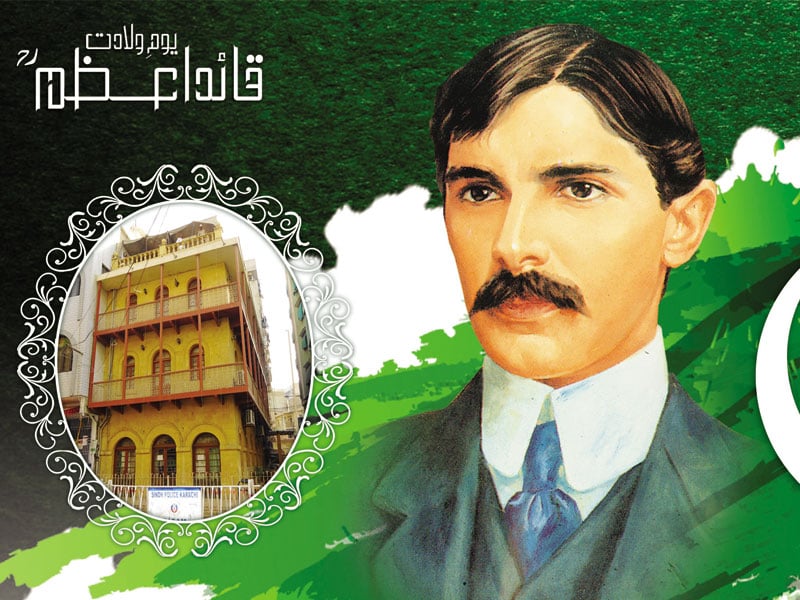Whenever there is an opportunity to express thoughts about Quaid-i-Azam Muhammad Ali Jinnah’s concept of Pakistan, immediately an impression of regret and regret also emerges.
If Pakistan was a reflection of the visions of its founder, there would be little need to verbally mention these visions. Instead, we would directly draw conclusions from the political situation of our country, look at our surroundings and say with great pride that this is the picture of the visions of the founders of Pakistan and their practical interpretation.
But despite chanting the name of Quaid-i-Azam day and night, his thoughts and ideas and his thinking and feeling have no place in our national life. Most of Quaid-e-Azam’s speeches remained unpublished until years after his death.
Some of Quaid-e-Azam’s statements were not allowed by the rulers to come before the nation. It is now on record that his thought-provoking speech of 11 August 1947 was tried to be censored by the then bureaucracy. Even now the situation is that Quaid-e-Azam’s sermons are missing in most of the languages spoken in the country.
In the past, only those aspects of Quaid-e-Azam’s biography could come to the public which were approved by the governments.
Those brilliant aspects of Quaid-e-Azam’s life which did not match our state policies were cleverly destroyed or hidden behind colorful curtains. Unfortunately, we have not only stumbled in understanding the ideas and thoughts of Quaid-e-Azam and his way of thinking, but as time passes, the number of such people has also increased.
Those who first presented new interpretations of Quaid-i-Azam’s ideas and then started presenting their alchemy as the ideas of Quaid-i-Azam.
This process has been so long and its effects have reached so far that now the first responsibility of the present-day intellectuals is to immediately explore the concepts of Quaid-i-Azam, on which the expansion of time and distortionists. It has been struck.
Before mentioning the concepts of Quaid-i-Azam and explaining them, two basic points must be clarified. First of all, Quaid-e-Azam is rightly considered as one of the leaders who influenced his time with his extraordinary personal qualities, understanding of history and tact and played an important role in turning the situation around.
The great secret of his success lay in his understanding of objective situations. The importance of Quaid-e-Azam’s concepts also lies in the fact that these concepts, though personal, were the best reflection of the spirit of the age.
Another noteworthy thing in understanding the concepts of Quaid-e-Azam is that despite the changes in his behavior or his reactions to various issues, it is not too difficult to discover his independence of thought and action on the most important issues. Some people have pointed out the inconsistencies in the stand taken by Quaid-e-Azam at different times regarding Hindu-Muslim relations, unity of India or other such topics.
This is the result of not understanding the difference between Quaid-e-Azam’s argument and his argument. Quaid-e-Azam’s status was a diligent and knowledgeable lawyer in the case of Muslims. He entered Indian politics in the second decade of the 20th century and made it his mission to represent Muslims and find the best practical interpretation of their cause.
This period was a period of all-round changes in Indian politics, political movements, constitutional reforms and various trends of conflict and cooperation. Apart from the ever-changing political situation, it was also clear that the future of India was yet to be decided.
In such a situation, as the lawyer of the Muslim case, the arguments of Quaid-e-Azam, his words and his vocabulary also changed. Apparently, the blind have taken the terms used by Quaid-i-Azam and his dictionary as their goal, which results in them being forced to see contradictions in his politics.
The question is, what was the real goal of Quaid-e-Azam or what was his real defendant? The answer to this question is so important that if the purpose of Quaid-i-Azam is understood, then the knots of his ideas and thoughts also begin to unravel.
Basically, Quaid-e-Azam wanted to ensure social justice and political and democratic rights for the Muslims of the subcontinent.
Initially, he wanted to achieve this goal in the background of a united India and when he did not find it possible to achieve this goal within a united India, then he proposed a separate state for the same purpose. The concept of a separate state was not one of the basic principles of religion for Quaid-e-Azam, which he had believed in at a certain stage of his life, but it was closed to other proposed avenues for achieving social and political rights for the Muslims of the subcontinent. After leaving was the only and inevitable way to survive.
Once he decided to take this path, his arguments also turned in that direction. He made Muslim nationality the basis of his demand, but while doing so, he was making only one argument. Muslim nationhood was not their goal but the political argument to achieve their goal.
As far as the issue of social justice is concerned, there is no room for variation in the views of Quaid-i-Azam.
Among the different interpretations of the Pakistan Movement, one interpretation is that it was driven by the interests of Muslim capitalists or the Muslim bourgeois class.
In a research paper, Hanna Papanek has revealed the true ambitions of the Muslim bourgeoisie of Bombay, Gujarat and Calcutta who believed that after the establishment of Pakistan, they would continue to establish their commercial and industrial centers in India, while Pakistan did not. Everything will pave the way for him.
Quaid-e-Azam was forced to accompany the Muslim capitalists because the Muslim League needed funds, but he was also not ignorant of the greed of the capitalists and landlords. So in 1943, in the annual meeting of the All India Muslim League held in Delhi, he had warned that:
“Pakistan will have a people’s government and here I warn the feudal lords and capitalists who are flourishing under a cruel and ugly system that has made them too selfish to talk sense with them.” It has become difficult. Looting the people has become part of their blood.
They have forgotten the lessons of Islam. Greed and selfishness have convinced these people to become fat by subordinating the interests of others to their own interests.
I have gone to the villages, there are millions and millions of our people who do not have the fortune of one hour of bread a day. Is this civilization? Is this the purpose of Pakistan? … If this is the concept of Pakistan, then I am not in favor of it.
These views of Quaid-e-Azam about civil justice and the economic well-being of a common Muslim are his own interpretation. They are as desolate today as they were half a century ago.
The second most important goal in Quaid-e-Azam’s life mission was to protect the political and democratic rights of the Muslims of the subcontinent.
Quaid-e-Azam’s democratism is the only point of view for a wide circle. For example, the general opinion of Congress writers is that Jinnah could not reconcile himself to democracy. And when the stage of India’s independence came, they demanded a separate state for the Muslims in view of the idea that now the Hindu majority would always come to power.
It is noteworthy that between 1940 and 1947, Quaid-e-Azam himself apparently expressed distrust of democracy against the backdrop of undivided India.
Before interpreting Quaid-e-Azam’s position during this period and evaluating his complete thinking about democracy, it is necessary to repeat once again that Jinnah’s arguments given at a particular time should be considered as his final argument. A great confusion can lead to controversy.
(Director Pakistan Study Center, University of Karachi)
(function(d, s, id){
var js, fjs = d.getElementsByTagName(s)[0];
if (d.getElementById(id)) {return;}
js = d.createElement(s); js.id = id;
js.src = “//connect.facebook.net/en_US/sdk.js#xfbml=1&version=v2.3&appId=770767426360150”;
fjs.parentNode.insertBefore(js, fjs);
}(document, ‘script’, ‘facebook-jssdk’));
(function(d, s, id) {
var js, fjs = d.getElementsByTagName(s)[0];
if (d.getElementById(id)) return;
js = d.createElement(s); js.id = id;
js.src = “//connect.facebook.net/en_GB/sdk.js#xfbml=1&version=v2.7”;
fjs.parentNode.insertBefore(js, fjs);
}(document, ‘script’, ‘facebook-jssdk’));


